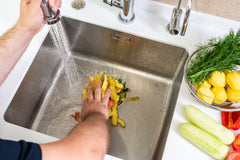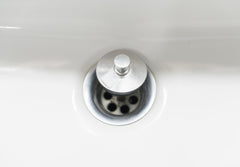Maybe you’ve just installed a new sink. Or maybe the sink stopper is not working as it should. In such situations, you might have to fix a new drain stopper or replace some components of your drain assembly.
Hiring a plumber to fix your drain assembly can be very costly. The good news is you can learn how to fix sink stoppers yourself, thus saving lots of money. Whatever problem your pop-up mechanism might have, you can find replacement parts in many hardware stores.
In this article, you will learn how pop-up stoppers work and how to fix sink stoppers.
What Is a Sink Stopper?
A sink stopper is a device that helps firmly close a drainage outlet. When the drainage outlet is closed, the sink can fill with water or other liquids. Though sink stoppers are usually found in the bathroom or kitchen, they can also be used for your basins and bathtubs.
Sink stoppers are available in a wide range of metal finishes to match the kind of faucet hardware you have. The lower components of the drain assembly could be made of less expensive plastic or durable metal.
It’s always good to find ways to avoid extra maintenance. For a sink strainer you can install and forget about, try SinkShroom. It’ll catch objects before they fall down the drain so you can avoid clogs.
So, How Do Sink Stoppers Work?
To understand how sink stoppers work, you should first get familiar with the different parts of this mechanism and their functions.
Here’s what makes up a typical pop-up:
- Pivot rod: This rod pushes the stopper up and down.
- Lift rod: This is the handle you pull to raise or lower the stopper. The rod runs through the sink and links with the clevis below.
- Clevis: The clevis is a forked or U-shaped metal fastening device that has two holes which hold a pin in place.
- Clevis strap: The clevis strap links the lift rod to the pivot rod.
- Clevis screw: This screw secures the clevis strap to the lift rod.
- Spring clip: The clip connects the pivot rod to the clevis strap.
- Seal: The seal covers the hole where the pivot rod goes into the drainage pipe.
- Stopper: This seals the throat of the drain pipe. When it is down, water is retained in the sink. To allow the water to drain, simply raise the stopper.
- P-trap: The p-trap refers to the bent section in your drainpipe, which allows waste and water to flow through but retains a little water to form a seal. This prevents gases from the sewer from coming out through the pipe into your home. Some p-traps also come with a clean-out plug which allows you to clean the trap without pulling out the trap completely.
- Drain pipe: This is the last part of the sink’s drain system. Water and waste flows out of the p-trap, into the drain pipe, and then out towards the sewer system.
The working of a sink pop-up mechanism is fairly simple. When the lift rod is up, it pulls up the clevis strap and the pivot rod, opening the drain. The stopper is then pulled down, sealing the sink.
A Step-by-Step Guide to Installing a Pop-Up Drain Stopper

Installing a sink stopper is quite simple. Here is what you’ll need for the job:
- Channel-type plier (or adjustable wrench)
- Bucket
- Pipe joint compound
- Plumber’s putty
- Pop-up drain assembly
Step 1: Remove the Current Drain Assembly
Before removing the current assembly, shut off the water supply. Using channel-type pliers, loosen and remove the p-trap from the sink drain tailpiece and branch drain.
With some traps, you will be able to remove the trap by hand without using a wrench. All you need to do is hold the p-trap firmly with one hand while using the other hand to rotate the nuts counterclockwise. Since there might be some water within the trap, be sure to place a bucket beneath to catch the water.
Next, pull out the old pop-up linkage assembly (if one exists). Use the channel-type pliers to extract the mounting nut from the old drain assembly’s tailpiece. Lift the whole drain assembly clear of the sink. You might have to wiggle the tailpiece a little to break the seal on the drain flange. Read our previous article to learn more about how to remove a drain stopper.
Step 2: Prepare the New Pop-up Stopper
Disassemble the new pop-up assembly. Next, unscrew and pull out the mounting nut or locking nut which is threaded on the tailpiece. Once this is done, install the plastic washer and the rubber washer (in that order) on top of the mounting nut. Be sure to push them all the way down.
Step 3: Apply Pipe Joint Compound
Also known as pipe dope, pipe joint compound is used to seal and lubricate threaded joints. Using pipe joint compound ensures an air- and water-tight seal. When buying the compound, make sure it can work for all types of metal and plastic threaded pipes.
Apply a layer of pipe dope to the top of the rubber washer. This will allow it to make a tight seal against the bottom of the sink drain opening.
Step 4: Apply Plumber’s Putty
Plumber’s putty is a pliable, soft-sealing compound which creates watertight seals around drains, faucets and other sink fixtures. Unlike silicone and other types of materials, plumber’s putty is not an adhesive and is easy to remove when needed.
Take a ball of plumber’s putty and roll it to form a long “rope,” then press it around the edge of the drain ring. This will help seal the upper part of the pop-up assembly to the sink drain opening. Some drain assemblies come with a rubber gasket or foam that you can use instead of caulk or plumber’s putty.
Step 5: Connect the Drain Parts
Insert the pop-up drain tailpiece into the drain opening under the sink, and push it up as high as you can. From above the sink, fit the drain ring into the opening and thread it into the tailpiece as far as possible by hand. Make sure the pieces are threaded properly and not cross-threaded.
Step 6: Tighten the Drain Assembly
While holding the tailpiece in place, use the channel-type pliers to tighten the mounting nut. Make sure the tailpiece opening where the pivot rod will fit points towards the wall behind the sink. Scrape away any plumber’s putty that oozes out and store it for future use.
Step 7: Insert the Pop-up Stopper

Insert the drain stopper in the bathroom sink opening. From below the sink, insert the pivot rod into the hole on the tailpiece’s side. Screw the pivot rod nut while ensuring that the pivot ball is properly positioned inside the tailpiece. Test the pivot rod to see if the pop-up stopper goes up and down freely. When you are sure everything is working properly, tighten the nut.
Step 8: Install the Pop-up Lever
Insert the vertical pop-up lever (also known as the lift rod) in the hole behind the bathroom faucet. From under the sink, attach the clevis strap to the end of the lift rod and tighten the screw.
Step 9: Connect the Pivot Rod and Pop-up Lever
Connect the horizontal pivot rod to the vertical clevis strap using a spring clip. Attach one end of the clip to each side of the strap. Test the assembly to ensure that the drain stopper closes and opens fully inside the drain opening. If it does not, you might want to make some adjustments.
Step 10: Reattach the Drain Trap
Reconnect the p-trap to the drain tailpiece and drain pipe. To test for leaks, close the stopper, fill the sink with water and open the stopper. As the water drains, check for any leaks. If there are leaks, tighten the connections using channel-type pliers. However, take care not to over-tighten them since they could break.
noreferrer">
Learn How to Fix Sink Stoppers DIY-Style
You will need to fix a new sink stopper when you install a new sink or buy a faucet that comes with its own stopper, or when the stopper doesn’t work as it should.
The first step in fixing sink stoppers is getting familiar with the components of a pop-up assembly. This includes the lift rod, clevis strap, pivot rod, spring clip, and the stopper itself. The process of installing the pop-up assembly is fairly easy and straightforward.
Are you looking to eliminate plumbing problems and clogged drains for good? Look no further than our complete 'Shroom drain protection line! We have award-winning solutions for every drain in your home.





0 comments